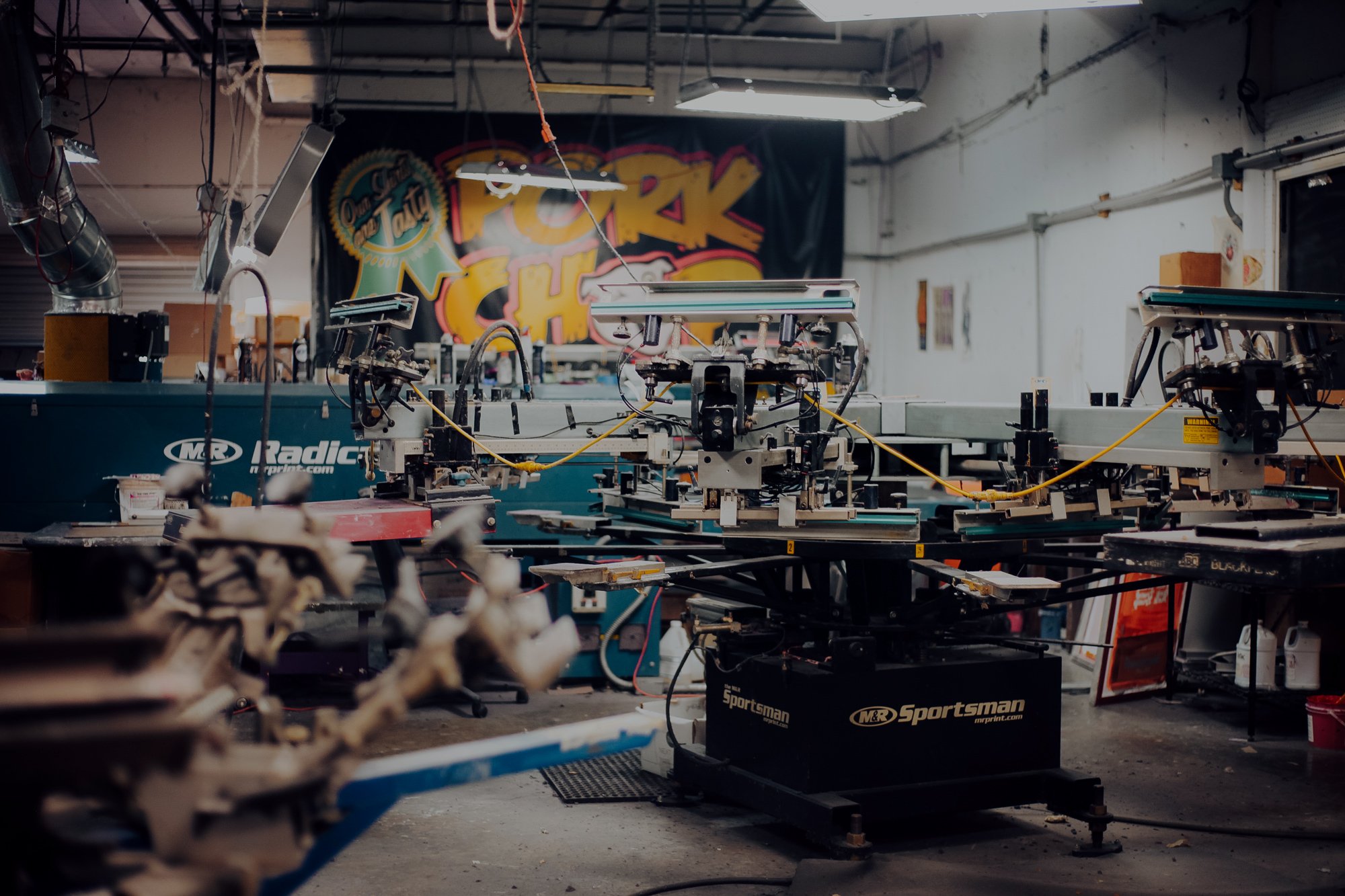Complete Screen Printing Kit for Artists and Creators
Complete Screen Printing Kit for Artists and Creators
Blog Article
Screen Printing Uncovered: Every Little Thing You Required to Find Out About Tee and Garment Printing Methods
Display printing is an interesting technique that integrates art with method, supplying countless opportunities for creative thinking. All set to discover the vital aspects that make display printing an art form?
The Essentials of Display Printing: How It Functions
When you dive into screen printing, you'll find it's both an art and a scientific research. At its core, display printing involves developing a stencil, or screen, that allows ink to go through only in specific locations (screen printing kit). You start by choosing your design and preparing your display with a light-sensitive emulsion. As soon as you subject this solution to light, it sets, leaving your layout as a negative space.
Setting the display over the textile, then use a squeegee to press ink via the screen onto the garment. Each action is important, and mastering them will boost your display printing abilities, changing basic garments into unique, expressive pieces.
Sorts Of Display Printing Techniques
Once you understand the fundamentals of screen printing, it's time to discover the numerous strategies that can elevate your designs. One prominent approach is typical display printing, where ink is pushed with a stenciled screen. This method is fantastic for vibrant, lively shades. There's water-based ink printing, which provides a softer feel and is eco-friendly, however it calls for a various strategy to healing.
One more option is plastisol printing, known for its toughness and dazzling shades, making it a preferred for numerous brand names. Experiment with halftone printing to develop gradient impacts and intricate styles.
Crucial Devices for Display Printing
To accomplish magnificent outcomes in screen printing, having the best tools is essential. You'll require a tough display printing framework, which holds the mesh that moves your layout onto the garment. Next off, spend in top notch mops; these are crucial for applying ink equally across the screen.
Selecting the Right Inks and Products
When picking inks and materials for display printing, you require to consider the kind of ink that works finest for your task. Consider textile compatibility to assure your designs look excellent and last long. Likewise, explore environmentally friendly ink alternatives to make your printing procedure much more sustainable.
Kinds Of Screen Inks
Picking the appropriate screen ink is vital for attaining lively, long lasting prints that satisfy your project's needs. There are a number of sorts of screen inks to check out. Plastisol ink is popular for its convenience and ease of usage, giving superb shade opacity on dark materials. Water-based ink, on the other hand, provides a softer feel and is environment-friendly, making it perfect for those aiming to reduce their environmental effect. Discharge inks remove dye from the textile, resulting in a soft, vintage look but call for details handling. Ultimately, specialty inks, such as metal or glow-in-the-dark, can include unique impacts to your designs. Evaluate your job needs and pick the ink that straightens ideal with your preferred outcome.

Fabric Compatibility Factors To Consider
Understanding fabric compatibility is important for attaining top quality display prints, especially considering that different materials react distinctly to various inks. Always check your inks on example material to ensure they stick appropriately and preserve color stability. Additionally, keep in mind that fabric weight and structure can affect the last result, so selecting the right ink and product combination is important for your task's success.
Eco-Friendly Ink Options
Environmentally friendly inks are becoming a popular selection for display printers who intend to decrease their environmental effect while keeping high quality. When picking inks, think about water-based inks, which are much less unsafe and simpler to tidy up compared to typical solvents. These inks bond well with fabrics, providing lively results without poisonous chemicals. You may also explore eco-solvent inks that utilize fewer unpredictable natural compounds (VOCs), making them a much safer alternative for both your wellness and the earth.
In addition, try to find inks made from renewable energies, such as soy or vegetable-based options. By selecting the best inks and materials, you'll not only produce magnificent styles yet likewise add to a much more lasting printing procedure. Make the button, and your prints will reflect your commitment to the environment!
Preparing Your Style for Display Printing

File Layout Needs
To ensure your style looks lively and sharp on fabric, you'll need to pay close focus to submit style requirements for screen printing. Make certain your style has a transparent background to prevent undesirable white sides on your prints. Maintain shade modes in mind; CMYK is common for screen printing, so convert your RGB develops as necessary.
Shade Splitting Up Techniques
Color separation is a vital action in Website preparing your style for display printing, and mastering it can greatly boost your print top quality. You'll require to damage your design into specific colors, as each color needs a separate screen during printing. This accuracy not just ensures precise shade representation however additionally improves the printing process.
Resolution and Dimension
Accomplishing the most effective cause screen printing starts with guaranteeing your design has the right resolution and size. Ideally, your art work must be at least 300 DPI (dots per inch) for sharp, clear prints. If you use lower resolution, your last item may look pixelated and less than professional.
When it involves dimension, think about the dimensions of your print location. Design your art work to match the last print dimension, ideally creating it in the real measurements you'll be printing. This way, you'll prevent any kind of unforeseen scaling problems.
Always examine your layout in both vector and raster styles. Vector graphics can be scaled without losing top quality, making them optimal for display printing. Preparing properly will assure your design looks fantastic on every garment!
Step-by-Step Display Printing Refine
Display printing is a dynamic process that permits you to develop vibrant designs on various surfaces. To start, you'll need a screen, emulsion, and your selected ink. Prepare your display by cleaning it thoroughly. Next off, apply the solution equally and let it dry in a dark area. As soon as dry, expose your display to light with your style positioned on it, which will certainly harden the emulsion where the light hits, developing a pattern - screen printing kit.
After rinsing the unexposed solution, your screen is all set. Set it up on your printing surface and align your garment underneath it. Put ink onto the display and use a squeegee to push the ink through the stencil onto the material. Raise the screen thoroughly and allow the print completely dry. Ultimately, cure the ink using heat to assure longevity. That's it! You have actually effectively screen published your design.
Tips for Effective Screen Printing Projects
While you're diving into your display printing projects, bear in mind that prep work is vital to success. Start by gathering all your materials-- inks, displays, squeegees, and garments. A tidy workspace assists avoid unwanted errors, so neat up before you begin.
Next, confirm your artwork is you can try here high-resolution and correctly sized for your garment. Test your display for appropriate direct exposure and tidy it thoroughly to stay clear of smudges. When blending your inks, comply with the manufacturer's standards to accomplish the appropriate uniformity.
During printing, use even stress with your squeegee for constant results. Don't rush; take your time to verify each print meets your standards. After printing, let your garments completely dry completely prior to dealing with or packaging them.
Lastly, always maintain a sample of your help future reference. This way, you can assess your progression and boost your strategies over time. Pleased printing!

Regularly Asked Inquiries
How much time Does It Require To Establish a Screen Printing Work?
Establishing a screen printing work usually takes around 30 minutes to an hour. You'll prepare the displays, mix inks, and change journalism. The time differs based upon complexity and experience, so remain organized!
Can I Print on Various Material Enters Using the Exact Same Technique?
Yes, you can print on different textile types using the exact same technique, yet you'll require to readjust your setups and inks. Some materials soak up ink in a different way, so experimenting guarantees the very best results for every product.
What Prevail Mistakes to Prevent in Display Printing?
When display printing, stay clear of typical errors like utilizing the incorrect ink, neglecting proper exposure times, or avoiding pre-press checks. Constantly check your configuration and keep clean screens to assure high quality outcomes each time.
How Can I Effectively Clean and Keep My Display Printing Equipment?
To properly tidy and maintain your display printing devices, you should routinely clean screens with suitable solvents, examine squeegees for wear, and guarantee all devices are saved completely dry and dust-free. Uniformity avoids costly fixings and enhances performance.
Is Screen Printing Ecologically Friendly Compared to Various Other Approaches?
Display printing can be much more eco-friendly than various other methods, specifically if you utilize water-based inks and eco-conscious materials. By picking sustainable materials and techniques, you minimize waste and lessen your influence on the world.
Screen Printing Uncovered: Every Little Thing You Need to Know About Tee Shirt and Garment Printing Methods
At its core, screen printing involves developing a stencil, or display, that allows ink to pass via just in specific areas. Placement the display over the textile, then utilize a squeegee to press ink via the display onto the garment. One preferred approach is traditional display printing, where ink is pushed with a stenciled display.When choosing inks and materials for screen printing, you need to take into account the type of ink that functions ideal my response for your task.
Report this page